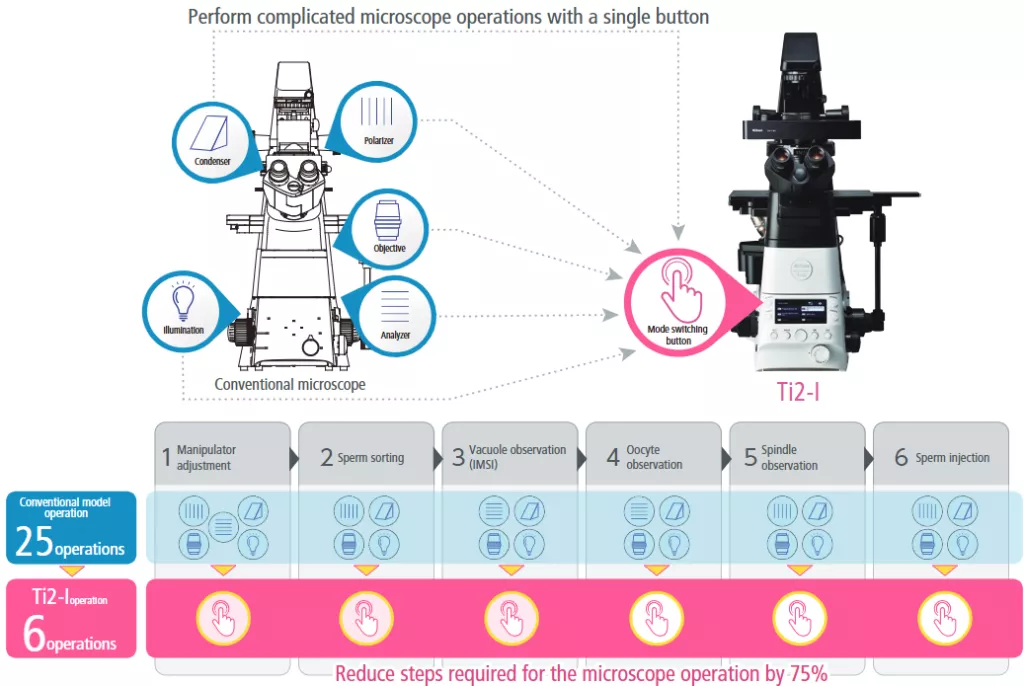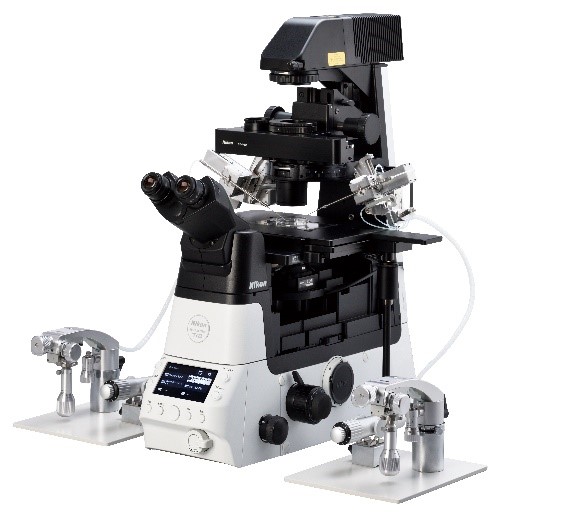Nikon Europe B.V. (Nikon) will launch the ECLIPSE Ti2-I Motorized Inverted Microscope for ICSI*3/IMSI*4, specialized for use in micro-insemination, from July 5. By allowing the microscope settings to be automatically controlled via simple buttons and a touch screen close to your hands – we’ve improved efficiency by reducing the steps required for operation by approximately 75%. An alert function and bright, clear field of view support accurate operation.
Approximately 75%*1 reduction in the steps required for microscope operation of an embryologist responsible for assisting in reproductive technology
The declining birthrate has become a social issue in developed countries. Along with women’s advancement in society and giving birth later in life, the number of births in 2019 (per 1000 people) decreased compared to the 1970s in major European countries*5. Governments and related organizations in numerous countries are promoting treatment methods to patients and medical institutions and providing financial support*6. As a result, the number of infertility treatments in Europe has increased by 1.8 times from 600 thousand*7 in 2011, to 1 million cycles in 2019*8. Embryologists*9 support these treatments.
*1 Calculated by comparing with the conventional model based on the number of processes in an example workflow. According to Nikon
*2 Photo with the manipulator of Narishige Lifemed Co., Ltd. installed
*3 Intracytoplasmic Sperm Injection: Method to inject sperm directly into the egg while observing with a microscope
*4 Intracytoplasmic Morphologically Selected Sperm Injection: Method to select sperm used for ICSI using a high magnification microscope while evaluating and observing the morphology and structure of sperm in more detail
*5 Birth rate, crude (World Bank)
*6 Implementing agencies in major countries (Bundesministerium für Familie, Senioren, Frauen und Jugend, Human Fertilization and Embryology Authority, Ministero della Salute)
*7 “Cycle” refers to the progress of the treatment plan in infertility treatment. It usually refers to the number of menstrual cycles; however, this term is used because treatment is often planned and implemented based on women’s menstrual cycle in infertility treatment
*8 Calculated based on “ART in Europe, 2019: results generated from European registries by ESHRE” (Human Reproduction, 2023, 38(12), 2321–2338)
*9 Medical profession to cultivate and manage fertilized eggs and embryos
While the workload of embryologists has increased with the increase in the number of infertility treatments, accuracy in their work remains an important factor. In response to these challenges, Nikon has launched the ECLIPSE Ti2-I to help reduce the workload of embryologists. The ECLIPSE Ti2-I is specialized for use in ICSI and IMSI, which contributes to the improvement of fertility treatment technology
| Product Name | ECLIPSE Ti2-I Motorized Inverted Microscope for ICSI/IMSI |
| Release Date | July 5, 2024 |
MAIN FEATURES
1. REDUCES APPROXIMATELY 75% OF THE STEPS REQUIRED FOR MICROSCOPE OPERATION AND IMPROVES MICRO-INSEMINATION WORKFLOW PRODUCTIVITY
In the micro-insemination procedure, where sperm is injected into the egg using a microscope, there are 6 main processes, such as micromanipulator adjustment, detailed observation of sperm and egg, and sperm injection. With manual microscope models, complex settings for the objective, illumination, condenser, and other components are required for each process. With the ECLIPSE Ti2-I, multiple observation settings for each process are consolidated into simple buttons at the front of the microscope, allowing switching of the observation modes with a single touch. There are 6 buttons to which modes can be allocated, improving the efficiency of micro-insemination workflows where observation modes are frequently changed.

2. DISPLAY THAT ALLOWS INTUITIVE OPERATION AND CONTRIBUTES TO THE PREVENTION OF OPERATIONAL ERRORS
The ECLIPSE Ti2-I has been specifically designed for user-friendliness to reduce errors. It features an angled touch screen and integrated buttons conveniently placed at the front of the microscope for easy operation. The touch screen enables users to easily review the currently selected observation method and provides status and error messages in case a user needs to be alerted.


Displaying configuration error warnings.The detailed information screen shows what needs to be corrected.
3. BRIGHT AND CLEAR OBSERVATION WITH NIKON’S UNIQUE OPTICAL TECHNOLOGY
Eggs and sperm can be observed clearly by improving the brightness of the field of view with Nikon’s unique optical technology. While visualizing the spindle*10 in an egg is important in micro-insemination, it is difficult to observe the spindle with a normal microscope. The ECLIPSE Ti2-I can display a hard-to-see spindle in color in all directions, making it easy to identify the spindle even if the orientation of the egg is changed. Through colors, the spindle can easily be distinguished from intracellular structures such as vacuoles. Nikon spindle observation system helps the embryologist avoid damaging the spindle of the egg during sperm injection. In addition, the presence and morphology of the spindle may be used to determine if the oocyte is mature enough for injection.
*10 This structure is formed for cell division and can be observed when the egg matures. The spindle identifies the position of the nucleus, allowing micro-insemination to be performed without damaging the nucleus.

Images of the spindle displayed in color. The arrows indicate the position of the spindle. (Courtesy of: Reproduction Clinic Tokyo)
・ ECLIPSE Ti2-I product page: https://www.microscope.healthcare.nikon.com/en_EU/products/inverted-microscopes/eclipse-ti2-i
・ECLIPSE Ti2-I customer interview: https://www.microscope.healthcare.nikon.com/en_EU/products/inverted-microscopes/eclipse-ti2-i/interview-minatomirai-yume-clinic
・ECLIPSE Ti2-I application notes: https://www.microscope.healthcare.nikon.com/en_EU/products/inverted-microscopes/eclipse-ti2-i/application-notes



